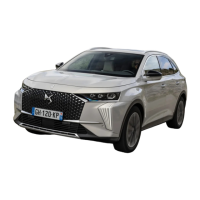89
Safety
05
Locations for child seats secured using the seat belt
In accordance with European regulations, this table indicates the options for installing child seats secured using the seat belt and universally approved (a) in
relation to the weight of the child and the seat position in the vehicle.
Weight of the child/indicative age
Seat Front passenger
airbag
Under 13 kg
(groups 0 (b)
and 0+)
Up to about 1
year old
From 9 to 18 kg
(group 1)
From about 1 to
3 years old
From 15 to 25 kg
(group 2)
From about 3 to
6 years old
From 22 to 36 kg
(group 3)
From about 6 to
10 years old
Row 1 (c) Passenger seat
with height
adjustment
(d) or without
height
adjustment (e)
Deactivated
"OFF"
U U U U
Activated "ON" X UF UF UF
Row 2 (f) Outer rear seats
Centre rear seat
(c) (g)
UF UF UF UF
U: seat position suitable for installing a child seat
secured using the seat belt and universally
approved for "rearward facing" and/or
"forward facing" use.
UF: seat position suitable for installing a
child seat secured using the seat belt and
universally approved for "forward facing"
use.
X: seat position not suitable for installing a child
seat of the weight group indicated.
(a) Universal child seat: child seat that can be
installed in all vehicles using the seat belt.
(b) Group 0: from birth to 10 kg.
Carrycots and "car" infant carriers cannot be
installed on the front passenger seat.
(c) Refer to the current legislation in your
country before installing your child on this
seat.
(d) The front height-adjustable seat must
be adjusted to the highest and fully back
longitudinal position.
(e) The backrest must be straightened.
(f) To install a "rearward facing" or "forward
facing" child seat at the rear, move the front
seat forward, then straighten the backrest to
allow enough room for the child seat and the
child's legs.

